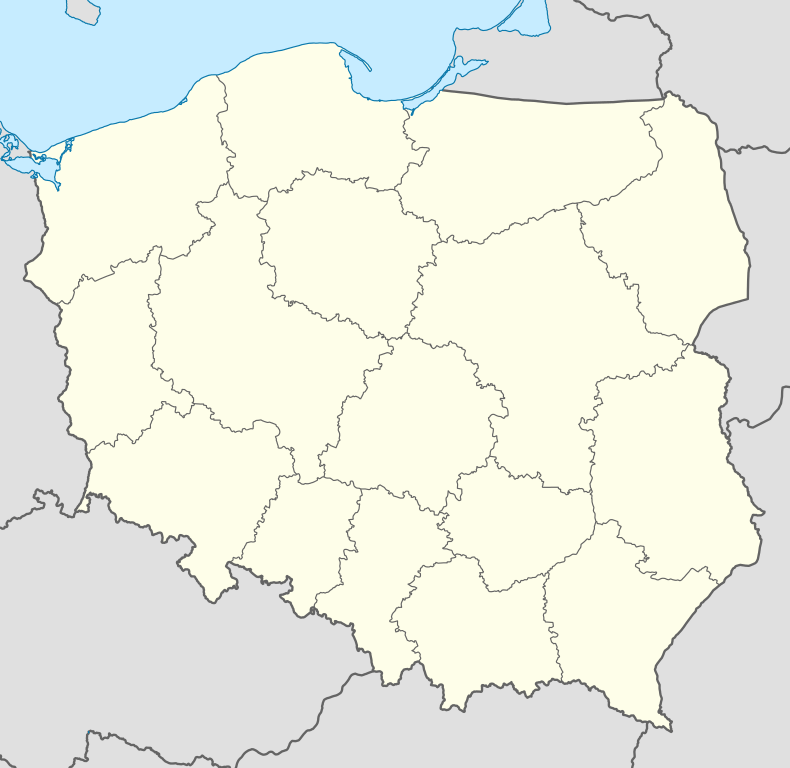Gliwice
| Gliwice | |||
|---|---|---|---|
|
Left to right: Town Hall, Radio station Gliwice wooden tower, Post Office, General view | |||
| |||
 Gliwice | |||
| Coordinates: 50°17′N 18°40′E / 50.283°N 18.667°E | |||
| Country |
| ||
| Voivodeship |
| ||
| County | city county | ||
| Established | 13th century | ||
| Town rights | 1250 | ||
| Government | |||
| • Mayor | Zygmunt Frankiewicz | ||
| Area | |||
| • City | 133.88 km2 (51.69 sq mi) | ||
| Highest elevation | 278 m (912 ft) | ||
| Lowest elevation | 200 m (700 ft) | ||
| Population (2013) | |||
| • City | 186,347 | ||
| • Density | 1,400/km2 (3,600/sq mi) | ||
| • Urban | 2,746,000 | ||
| • Metro | 4,620,624 | ||
| Time zone | CET (UTC+1) | ||
| • Summer (DST) | CEST (UTC+2) | ||
| Postal code | 44-100 to 44-164 | ||
| Area code(s) | +48 32 | ||
| Car plates | SG | ||
| Website | http://www.gliwice.eu/ | ||
Gliwice [ɡlʲiˈvʲit͡sɛ] (German: Gleiwitz) is a city in Upper Silesia, southern Poland, near Katowice. Gliwice is the west district of the Upper Silesian Metropolitan Union – a metropolis with a population of 2 million. The city is located in the Silesian Highlands, on the Kłodnica river (a tributary of the Oder).
Situated in the Silesian Voivodeship since its formation in 1999, Gliwice was previously in Katowice Voivodeship. Gliwice is one of the cities of a 2.7 million conurbation known as the Katowice urban area and is within the larger Silesian metropolitan area, which has a population of about 5,294,000 people.[1] The population of the city is 185,196 (March 2014).[2]
History
Late Middle Ages
In Slavic languages, the root gliw or gliv suggests terrain characterized by loam or wetland. In South Slavic languages, glive or gljive refers to mushrooms, with gljivice meaning little mushrooms.
Gliwice was first mentioned as a town in 1276 and was ruled during the Middle Ages by the Silesian Piast dukes.[3] During the reign of Mieszko I Tanglefoot, the town was part of a duchy centered on Opole-Racibórz, and became a separate duchy in 1289.[3] According to 14th-century writers, the town seemed defensive in character and was ruled by Siemowit of Bytom.[3] The town became a possession of the Bohemia crown in 1335, passing with that crown to the Austrian Habsburgs as Gleiwitz in 1526.
Early Modern Age
Because of the vast expenses incurred by the Habsburg Monarchy during their 16th century wars against the Ottoman Empire, Gleiwitz was leased to Friedrich Zettritz for the meager amount of 14,000 thalers. Although the original lease was for a duration of 18 years, it was renewed in 1580 for 10 years and in 1589 for an additional 18 years.
During the mid 18th century Silesian Wars, Gleiwitz was taken from the Habsburg Monarchy by the Kingdom of Prussia along with the majority of Silesia. After the end of the Napoleonic Wars, Gleiwitz was administered in the Prussian district of Tost-Gleiwitz within the Province of Silesia in 1816. The city was incorporated with Prussia into the German Empire in 1871 during the unification of Germany. In 1897 Gleiwitz became its own Stadtkreis, or urban district.
Industrialization
The first coke-fired blast furnace on the European continent was constructed in Gleiwitz in 1796 under the direction of John Baildon. Gleiwitz began to develop into a major city through industrialization during the 19th century. The town's ironworks fostered the growth of other industrial fields in the area. The city's population in 1875 was 14,156. However, during the late 19th century Gleiwitz had: 14 distilleries, 2 breweries, 5 mills, 7 brick factories, 3 sawmills, a shingle factory, 8 chalk factories and 2 glassworks.
Other features of the 19th century industrialized Gleiwitz were a gasworks, a furnace factory, a beer bottling company, and a plant for asphalt and paste. Economically, Gleiwitz opened several banks, Savings and loan associations, and bond centers. Its tram system was completed in 1892, while its theater was opened in 1899; until World War II, Gleiwitz' theatre featured actors from throughout Europe and was one of the most famous theatres in the whole of Germany.
20th century

According to the 1911 Encyclopædia Britannica, Gleiwitz's population in 1905 was 61,324. By 1911 it had two Protestant and four Roman Catholic churches, a synagogue, a mining school, a convent, a hospital, two orphanages, and a barracks. Gleiwitz was the center of the mining industry of Upper Silesia. It possessed a royal foundry, with which were connected machine factories and boilerworks. Other industrialized areas of the city had other foundries, meal mills, and factories producing wire, gas pipes, cement, and paper.
After the end of World War I, clashes between Poles and Germans occurred during the Silesian Uprisings. Ethnically Polish inhabitants of Upper Silesia wanted to incorporate the city into the Second Polish Republic. The differences between Germans and Poles led to the First and Second Silesian Uprisings, and German resistance against them. Seeking a peaceful solution to the conflict, the League of Nations held a plebiscite on 20 March 1921 to determine which country the city should belong to. In Gleiwitz, 32,029 votes (78.7% of given votes) were for remaining in Germany, Poland received 8,558 (21.0%) votes, and 113 (0.3%) votes were declared invalid. The total voter turnout was listed as 97.0%. This prompted the Third Silesian Uprising, which then forced the League to arbitrate. It determined that three Silesian towns: Gleiwitz, Hindenburg and Beuthen would remain in Germany, and the eastern part of Upper Silesia with its main town of Katowice (Kattowitz) would join restored Poland.

An attack on a radio station in Gleiwitz on 31 August 1939, staged by the German secret police, served as a pretext, devised by Reinhard Heydrich under orders from Hitler, for Nazi Germany to invade Poland, which marked the start of the Second World War. From July 1944 to January 1945, Gliwice was the location for one of the many sub-camps of the Auschwitz concentration camp.[4]
On 24 January 1945, Gliwice was occupied by Red Army The city was placed under Polish administration according to the 1945 Potsdam Conference and thus part of the Silesian-Dabrowa Voivodeship. Most of the German population was expelled according to the agreements made at the Potsdam Conference and replaced with Poles expelled from eastern, previously Polish lands annexed post war by the Soviet Union. It was incorporated into Poland's Silesian Voivodeship on 18 March 1945.
Higher education and science
Gliwice is a major applied science hub for the Upper Silesian Metropolitan Union. Gliwice is a seat of:
- Silesian University of Technology with about 32,000 students (Politechnika Śląska)
- Akademia Polonijna of Częstochowa, branch in Gliwice
- Gliwice College of Entrepreneurship (Gliwicka Wyższa Szkoła Przedsiębiorczości)[5]
- Polish Academy of Sciences (Polska Akademia Nauk)
- Institute of Theoretical And Applied Informatics
- Institute of Chemical Engineering
- Carbochemistry branch
- Other (commercial or government funded) applied research centers:
- Oncological Research Center (Centrum Onkologii)
- Inorganic Chemistry Research Institute (Instytut Chemii Nieorganicznej)
- Research Institute of Refractory Materials (Instytut Materiałów Ogniotrwałych)
- Research Institute for Non-Ferrous Metals (Instytut Metali Nieżelaznych)
- Research Institute for Ferrous Metallurgy (Polish: Instytut Metalurgii Żelaza)
- Welding Research Institute (Instytut Spawalnictwa)
Water transport
In Gliwice there exists Gliwice Canal (Kanał Gliwicki) which links Gliwice harbour to the Oder River and thus to the waterway network across much of Germany and to the Baltic Sea.
Older Kłodnica Canal (Kanał Kłodnicki) is no longer operational (it was decommissioned and filled in).
Sports
- Piast Gliwice – men's football team playing in Orange Ektraklasa (since season 2008/2009),
- Carbo Gliwice – men's football team,
- Sośnica Gliwice – women's handball team playing in Polish Ekstraklasa Women's Handball League: 10th place in 2003/2004 season.
- Gliwickie Towarzystwo Koszykówki – men's basketball team.
- P.A. Nova Gliwice – men's futsal team playing in 1st league (4 times Champion of Poland).
- Gliwice Cricket Club[6]
- K.S. Kodokan Gliwice [7] - martial arts team and club.
- Gliwice LIONS [8] - American Football team.
Politics
Bytom/Gliwice/Zabrze constituency
Members of Parliament (Sejm) elected from Bytom/Gliwice/Zabrze constituency
- Brzeziński Jacek, PO
- Chłopek Aleksander, PiS
- Gałażewski Andrzej, PO
- Głogowski Tomasz, PO
- Kaźmierczak Jan, PO
- Martyniuk Wacław, LiD
- Religa Zbigniew, PiS
- Sekuła Mirosław, PO
- Szarama Wojciech, PiS
- Szumilas Krystyna, PO
Municipal politics
President of city (Mayor) – Zygmunt Frankiewicz
Buildings

- The Gliwice Radio Tower of Radiostacja Gliwicka ("Radio Station Gliwice") in Szobiszowice is the only remaining radio tower of wood construction in the world, and with a height of 118 meters, is perhaps the tallest remaining construction made out of wood in the world.
- Gliwice Trynek narrow-gauge station is a protected monument. The narrow-gauge line to Racibórz via Rudy closed in 1991 although a short section still remains as a museum line.
- Castle in Gliwice dates back to the Middle Ages and hosts a museum.
International relations
Twin towns—Sister cities
Gliwice is twinned with the following cities:
Famous people

- John Baildon, Scottish engineer
- Richard Fritz Behrendt, German sociologist
- Horst Bienek, German author of novels about Upper Silesia
- Wolfgang Bittner, German author
- William Blandowski, zoologist, photographer
- Sebastian Boenisch, Polish-German footballer who plays for the Poland national football team
- Lothar Bolz, foreign affairs minister of the communist German Democratic Republic
- Adeltraut Thienel (Hayes), Actress, Socialite, Artiste, Dressmaker
- Agata Buzek, actress, daughter of Jerzy Buzek
- Jerzy Buzek, professor of chemistry, prime minister of Poland 1997–2001, MEP since 2004 and president of European Parliament since 2009
- Walther Busse von Colbe, German economist
- Ernst Degner, German Grand Prix motorcycle racer and designer
- Robert Dziekański, Polish immigrant to Canada who was tasered 5 times and killed by the Royal Canadian Mounted Police at Vancouver International Airport
- Gottfried Bermann Fischer, German publisher
- Christian Ganczarski, convert to Islam and convicted terrorist
- Eugen Goldstein, German scientist
- Sophia Grojsman (Khodosh), internationally famous USA perfumer
- Katarzyna Groniec, vocalist
- Hans Hanke, German military officer (World War Two).
- Alfred Hauptmann, German psychiatrist and neurologist of Jewish origin
- Rudolf Herrnstadt, German communist
- Hans Kneifel, German author
- Wojciech Kocyan, pianist
- Richard Kubus, German football player
- Emanuel Larisch, German communist politician
- Paul Latussek, Vice-president of the Association of German expellees (1992–2001)
- Jerzy Lewczyński, photographer
- Monika Lindner, director of the Austrian television ORF
- Włodzimierz Lubański,Polish football player
- Zbigniew Messner, professor and former rector of Economic Academy in Katowice, deputy prime minister of People's Republic of Poland 1983–1985, prime minister 1985–1988
- Gustav Neumann, German chess player
- Lukas Podolski, German (Polish-born) football player, Arsenal FC
- Adam Matuszczyk, Polish football player
- Tadeusz Różewicz, Polish poet and writer
- Zofia Rydet, photographer
- Stanisław Sojka, musician
- Oskar Troplowitz, pharmacist and owner of Beiersdorf AG, inventor of Nivea and other products
- Agnes Wabnitz, feminist
- Richard Wetz, composer
- Erich Peter Wohlfarth, German physicist
- Leo Yankevich, poet and translator
- Adam Zagajewski, poet
- Krystian Zimerman, Polish born, internationally famous pianist
- Christoph Zöpel, German politician (SPD)
See also
- Gliwice County
- Gliwice incident
Literature
- Max Lamla: Merkwürdiges aus meinem Leben (1917–1999), Saarbrücken 2006, ISBN 3-00-018964-5
- Boleslaw Domanski (2000) "The Impact of Spatial and Social Qualities on the Reproduction of Local Economic Success: The Case of the Path Dependent Development of Gliwice", in: Prace Geograficne, zesyt 106, Cracow, pp 35–54.
- B. Nietsche, Geschichte der Stadt Gleiwitz (1886)
- Seidel, Die königliche Eisengiesserei zu Gleiwitz (Berlin, 1896)
References
- ↑ European Spatial Planning Observation Network (ESPON), espon.eu
- ↑ Główny Urząd Statystyczny. Baza Demografia. Ludność. Stan, ruch naturalny i wędrówki ludności w I kwartale 2014 (as of 31 March 2014)
- ↑ 3.0 3.1 3.2 Official website of Gliwice - Dzieje miasta
- ↑ Infosite; retrieved 24 April 2011.
- ↑ GWSP.gliwice.pl
- ↑ Facebook.com
- ↑
- ↑
- ↑ "Oficiálne stránky mesta Kežmarok". kezmarok.sk. Retrieved 8 February 2010.
| Wikimedia Commons has media related to Gliwice. |
| Wikisource has the text of the 1911 Encyclopædia Britannica article Gleiwitz. |
- Um.gliwice.pl
- Web.archive.org
- Jewish Community in Gliwice on Virtual Shtetl
- Polsl.pl
- Gliwice.pl
- Gliwice.com
- Gliwice.zobacz.slask.pl
- Forumgliwice.com
- Gliwice.info.pl
- Aegee-gliwice.org, Travel Guide
| ||||||||||||
| |||||||||||||||||||||





